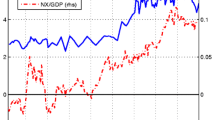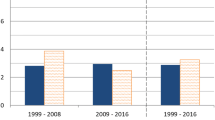Abstract
We study the contribution of market regulations to the dynamics of the real exchange rate within the European Union. Based on a model proposed by De Gregorio et al. (Rev Int Econ 2(3):284–305, 1994a), we show that both product market regulations in nontradable sectors and employment protection tend to raise the real exchange rate. We then carry out an econometric estimation for European countries for 1985–2006 to quantify the contributions of the pure Balassa–Samuelson effect and those of market regulations on real exchange-rate variations. Based on this evidence and on a counter-factual experiment, we conclude that the relative evolutions of product market regulations and employment protection across countries play a very significant role for real exchange-rate variations within the European Union and especially within the euro area, through their impacts on the relative price of nontradable goods.








Similar content being viewed by others
Notes
See Sect. 2.
The nontradable sector includes: electricity, gas and water supply, construction, wholesale and retail trade, hotels and restaurants. In turn, the tradable sector covers manufacturing, transport, storage, communication, and all primary sectors. Unfortunately the data do not extend consistently beyond 2006 (see Sect. 4).
Within the EU single market, changes in trade tariffs are no longer an issue.
See Bahmani-Oskooee and Nasir (2005) for a review.
We simplify the model by omitting government expenditures, the impact of which has been shown either neutral or ambiguous in the literature, (see De Gregorio et al. 1994b).
Here we drop time subscripts for the sake of clarity.
The first-order Taylor approximation of (24) around w 0 is given by \(L^d(w)=L^d(w_0)+(w-w_0)\partial L^d(w_0)/\partial w=L_0+\epsilon w\) where \(\partial L^d(w)/\partial w=\frac{1}{(1-\alpha)w}\left(\frac{\alpha a^T p^T}{pw}\right)^{1/(1-\alpha)}-\frac{(1-\gamma)Y^T}{\gamma(1+\beta)p w^2}, L_0=L^d(w_0)-w_0\partial L^d(w_0)/\partial w\) and \(\epsilon= -\partial L^d(w_0)/\partial w\). Like De Gregorio et al. (1994a), we neglect here the effect of labor demand parameters on \(\epsilon\).
Only the level of significance can be affected. We have checked the robustness of our results by changing the reference country. The results are available from the authors.
Using the last updated OECD databases, the PMR index is available from 1975 to 2007 for 29 OECD countries, while EP index is available for the period 1985–2013 for 43 countries (34 OECD countries and 9 emerging economies). Therefore, our sample starts in 1985. Due to missing values for the PMR index in 2007 and in order to get a balanced panel that is required by our estimation procedure (panel DOLS procedure of Mark and Sul 2003), our data cover the period 1985–2006.
Intermediate years are available but skipped here to save space.
Cross-sectional dependence in panel data settings results in nuisance parameter problems in the first-generation panel unit root tests (which assume cross-sectional independence). The Pesaran test relies on the cross-sectional augmented Dickey–Fuller (CADF, see below).
In contrast to the second-generation panel unit root tests, the third-generation panel unit root tests allow consideration of both cross-sectional dependency and structural breaks.
References
Andrews, D. W. K., & Monahan, J. C. (1992). An improved heteroskedasticity and autocorrelation consistent covariance matrix estimator. Econometrica, 60(4), 953–966.
Asea, P. K., & Corden, W. M. (1994). The Balassa–Samuelson model: An overview. Review of International Economics, 2(3), 191–200.
Asea, P. K., & Mendoza, E. (1994). The Balassa–Samuelson model: A general-equilibrium appraisal. Review of International Economics, 2(3), 244–267.
Bahmani-Oskooee, M. (1992). A time series approach to test the productivity bias hypothesis in purchasing power parity. Kyklos, 45(2), 227–236.
Bahmani-Oskooee, M., & Nasir, A. B. M. (2001). Panel data and productivity bias hypothesis. Economic Development and Cultural Change, 49(2), 393–402.
Bahmani-Oskooee, M., & Nasir, A. B. M. (2005). Productivity bias hypothesis and the purchasing power parity: A review article. Journal of Economic Surveys, 19(4), 671–696.
Balassa, B. (1964). The purchasing power parity doctrine: A reappraisal. Journal of Political Economy, 72(6), 584–596.
Biroli, P., Mourre, G., & Turrini, A. (2010). Adjustment in the euro area and regulation of product and labor markets: An empirical assessment. (CEPR Discussion Paper 8010). London: Centre for Economic Policy Research.
Blanchard, O., & Giavazzi, F. (2003). Macroeconomic effects of regulation and deregulation in goods and labor markets. The Quarterly Journal of Economics, 118(3), 879–907.
Bloch, L. (2012). Product market regulation, trend inflation and inflation dynamics in the new Keynesian Phillips curve. Economic Modelling, 29(5), 2058–2070.
Canzoneri, M. B., Cumby, R. E., & Diba, B. (1999). Relative labor productivity and the real exchange rate in the long run, evidence for a panel of OECD countries. Journal of International Economics, 47(2), 245–266.
Carrion-i-Silvestre, J. L., Barrio Castro, T. D., & Lópes Bazo, E. (2005). Breaking the panels: An application to the GDP per capita. Econometrics Journal, 8(2), 159–175.
Clague, C. K. (1986). Determinants of national price level: Some empirical results. The Review of Economics and Statistics, 68(2), 320–323.
Clague, C. K. (1988). Purchasing power parities and exchange rates in Latin America. Economic Development and Cultural Change, 36(3), 529–541.
Conway, P., & Nicoletti, G. (2006). Product market regulation in the non-manufacturing sectors of OECD countries: Measurement and highlights. (OECD Working Paper 530). Paris: Organisation for Economic Co-operation and Development.
Coudert, V., Couharde, C., & Mignon, V. (2013). On currency misalignments within the euro area. Review of International Economics, 21(1), 35–48.
De Broeck, M., & Sløk, T. (2006). Interpreting real exchange rate movements in transition countries. Journal of International Economic, 68(2), 368–383.
De Gregorio, J., Giovannini, A., & Wolf, H. C. (1994a). The behavior of nontradable goods prices in Europe: Evidence and interpretation. Review of International Economics, 2(3), 284–305.
De Gregorio, J., Giovannini, A., & Wolf, H. C. (1994b). International evidence on tradables and nontradables inflation. European Economic Review, 38(6), 1225–1244.
Egert, B., Drine, I., Lommatzsch, K., & Rault, C. (2003). The Balassa–Samuelson effect in Central and Eastern Europe: Myth or reality? Journal of Comparative Economics, 31(3), 552–572.
Frankel, J. (2006). The Balassa–Samuelson relationship and the Renmibi. Mimeo: Harward University.
Gros, D. (2012). Macroeconomic imbalances in the euro area, symptom or cause of the crisis? (CEPS Policy Brief 266). Brussels: Centre for European Policy Studies.
Heston, A., Summers, R., & Aten, B. (2011). Penn world table version 7.0. Center for international comparisons of production, income and prices at the University of Pennsylvania.
Hsieh, D. A. (1982). The determination of the real exchange rate: The productivity approach. Journal of International Economics, 12(3–4), 355–362.
Im, K. S., Pesaran, M. H., & Shin, Y. (2003). Testing for unit roots in heterogeneous panels. Journal of Econometrics, 115(1), 53–74.
Jaumotte, F., & Morsy, H. (2012). Determinants of inflation in the euro area: The role of labor and product market institutions. (IMF Working Paper 12/137). Washington, DC: International Monetary Fund.
Kao, C., & Chiang, M. H. (2001). On the estimation and inference of a cointegrated regression in panel data. Advances in Econometrics, 15, 179–222.
Kravis, I. B., & Lipsey, R. E. (1988). National price levels and the prices of tradables and nontradables. American Economic Review, 78(2), 474–478.
Mark, N. C., & Sul, D. (2003). Cointegration vector estimation by panel DOLS and long-run money demand. Oxford Bulletin of Economics and Statistics, 65(5), 655–680.
Obstfeld, M., & Rogoff, K. (1996). Foundations of international macroeconomics. Cambridge: MIT Press.
OECD. (2011). Product market regulation database. Paris: Organisation for Economic Co-operation and Development.
Pedroni, P. (2001). Fully modified OLS for heterogeneous cointegrated panels. Advances in Econometrics, 15, 93–130.
Pesaran, M. H. (2007). A simple panel unit root test in the presence of cross-section dependence. Journal of Applied Econometrics, 27(2), 265–312.
Phillips, P. C. B., & Hansen, B. E. (1990). Statistical inference in instrumental variables regressions with I(1) processes. Review Economic Studies, 57(1), 99–125.
Phillips, P. C. B., & Moon, H. R. (1999). Linear regression limit theory for non stationary panel data. Econometrica, 67(5), 1057–1111.
Przybyla, M., & Roma, M. (2005). Does product market competition reduce inflation? Evidence from EU countries and sectors. (ECB Working Paper 453). Frankfurt: European Central Bank.
Rodrik, D. (2008). The real exchange rate and economic growth. Brookings Papers on Economic Activity, 39(2), 365–412.
Rogoff, K. (1992). Traded goods consumption smoothing and the random walk behavior of the real exchange rate. Bank of Japan Monetary and Economic Studies, 10(2), 1–29.
Saikkonen, P. (1991). Asymptotically efficient estimation of cointegration regressions. Econometric Theory, 7(1), 1–21.
Samuelson, P. A. (1964). Theoretical notes on trade problems. Review of Economics and Statistics, 46(2), 145–164.
Sheng, Y., & Xu, X. (2011). Real exchange rate, productivity and labor market frictions. Journal of International Money and Finance, 30(3), 587–603.
Stock, J. H., & Watson, M. W. (1993). A simple estimator of cointegrating vectors in higher order integrated systems. Econometrica, 61(4), 783–820.
Strauss, J. (1995). Real exchange rates, PPP and the relative prices of nontraded goods. Southern Economic Journal, 61(4), 991–1005.
Strauss, J. (1996). The cointegration relationship between productivity, real exchange rates, and purchasing power parity. Journal of Macroeconomics, 18(2), 299–313.
Strauss, J. (1999). Productivity differentials, the relative price of non tradables and real exchange rates. Journal of International Money and Finance, 18(3), 383–409.
Turnovsky, S., & Sen, P. (1995). Investment in a two-sector dependent economy. Journal of the Japanese and International Economies, 9(1), 29–55.
Venn, D. (2009). Legislation, collective bargaining and enforcement: Updating the OECD employment protection indicators. Paris: Organisation for Economic Co-operation and Development.
Westerlund, J. (2007). Testing for error correction in panel data. Oxford Bulletin of Economics and Statistics, 69(6), 709–748.
Westerlund, J., & Edgerton, D. L. (2008). A simple test for cointegration in dependent panels with structural breaks. Oxford Bulletin of Economics and Statistics, 70(5), 665–704.
Wyplosz, C. (2013). Eurozone crisis: It’s about demand, not competitiveness. Mimeo, The Graduate Institute, Geneva, January.
Acknowledgments
This paper was written while both authors were researchers at CEPII. We are thankful to Gunther Capelle-Blancard, Benjamin Carton, Jacques Melitz and Valérie Mignon for their remarks on a preliminary version. The usual disclaimer applies.
Author information
Authors and Affiliations
Corresponding author
About this article
Cite this article
Bénassy-Quéré, A., Coulibaly, D. The impact of market regulations on intra-European real exchange rates. Rev World Econ 150, 529–556 (2014). https://doi.org/10.1007/s10290-014-0185-6
Published:
Issue Date:
DOI: https://doi.org/10.1007/s10290-014-0185-6




